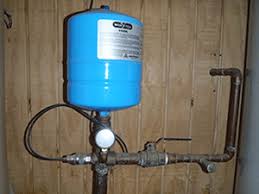Understanding Your Pressure Storage Tank
While often taken for granted, the pressure tank in your private water system plays a crucial role. Knowing its purpose and how it operates can help you maintain an efficient water system.
Purpose of a Pressure Tank
The pressure tank in a private water system serves three primary functions:
- Water Storage and Pressure Maintenance: It stores water and provides it under pressure when the pump is not running.
- Pump Longevity: By maintaining a reserve supply of water, the tank reduces the frequency of pump cycling, extending the pump’s life.
- High Demand Supply: It provides a reserve of water during times of high demand.
How Pressure Tanks Work
The operation of a pressure tank is based on the physical properties of water and air. Water cannot be compressed, but air can. When water is pumped into a tank containing air, the air compresses, creating pressure. The more the air compresses, the higher the water pressure. Typically, when the water pressure reaches 40 to 60 pounds per square inch (psi), the pump shuts off. As water is used and the pressure drops to 20 to 40 psi, the pump restarts. The minimum tank pressure must meet the requirements of all fixtures and appliances, often at least 10 psi, with some needing up to 30 psi.
Types of Pressure Tanks
There are various types of pressure tanks:
- Galvanized Steel Tanks: Common before 1970, these had air and water in direct contact, requiring air replenishment to avoid waterlogging.
- Galvanized Steel Tanks with Wafer: These use a floating wafer to separate air and water, reducing some of the issues of direct contact.
- Bladder Pressure Tanks: Popular since 1970, these have a bladder that separates water from air, preventing direct contact and reducing maintenance.
- Diaphragm Pressure Tanks: These use a membrane to separate water and air, functioning similarly to bladder tanks.
Sizing a Pressure Tank
The proper size of a pressure tank is often determined by the pump’s flow rate. For a typical pump with a flow rate of 5 to 10 gallons per minute (gpm), multiply the flow rate by four to determine the tank size. For instance, a 9-gpm pump would need a 36-gallon bladder or diaphragm tank. A galvanized steel tank without a wafer requires a size ten times the flow rate, meaning a 9-gpm pump would need a 90-gallon tank. Always consult with your pump supplier to determine the appropriate tank size, especially for low-yield wells.
Variable Frequency Drive (VFD) Systems
For modern water systems, especially with submersible pumps, VFD motor controllers are becoming popular. These systems, known as constant pressure water systems, adjust the pump motor speed to maintain constant pressure. As water usage increases, the pump speeds up, and as usage decreases, the pump slows down. These systems typically require only a small pressure tank, usually 1 to 2 gallons.
For more detailed information on pressure tanks and other water distribution system components, refer to the Nebraska Extension NebGuide “Private Drinking Water Wells: The Distribution System” by Jan R. Hygnstrom, Wayne Woldt, and Sharon O. Skipton.
